SDOT has released an update to the Bicycle Master Plan Implementation Plan (AKA the “Bike Plan Plan”), the guiding document that distills the 20-year citywide plan down to a list a achievable projects over the next five years.
The total budget for Bike Master Plan projects in 2015 is now expected to reach $19 million, though $6.5 million of that has been carried over from 2014 (and it’s likely some of that $19 million will also be carried over to 2016). The 2015 plan calls for the city to build or start construction on 7.5 miles of protected bike lanes and 12.6 miles of neighborhood greenways. They will also install 225 bike racks and 15 bike corrals.
And, of course, the city is investing $600,000 to expand Pronto into the Central District, Yesler Terrace and International District and $400,000 from a Federal grant to increase low-income access to the bike share system.
There’s a lot here to be excited about. Here’s the 2015 map:
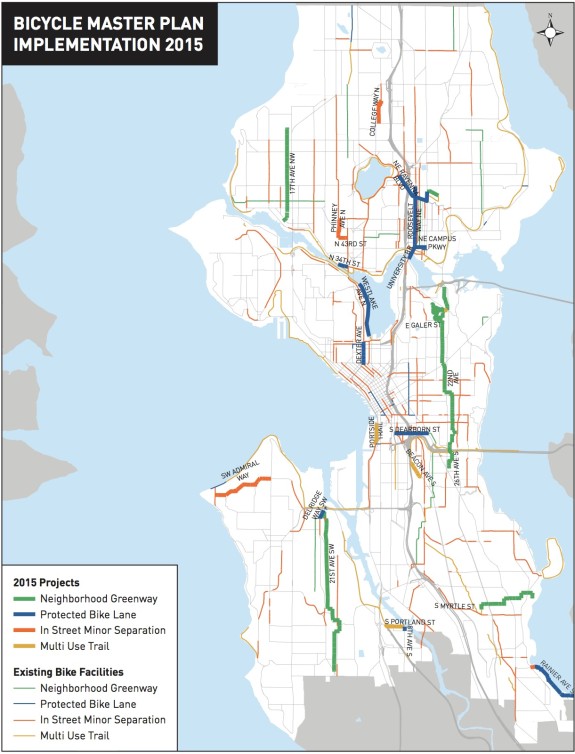 In addition to all these projects, the city will be studying and designing some big projects for construction in 2016. Most notably, 2016 could be the year downtown finally has a usable and connected network to protected bike lanes.
In addition to all these projects, the city will be studying and designing some big projects for construction in 2016. Most notably, 2016 could be the year downtown finally has a usable and connected network to protected bike lanes.
There will also be some exciting projects in the far north end and a big neighborhood greenway through Rainier Valley. And a protected bike lane project on Gilman, Emerson and 20th Ave NW would finally connect the Ship Canal Trail to the Elliott Bay Trail. West Seattle, I guess you get nothing. Sorry.
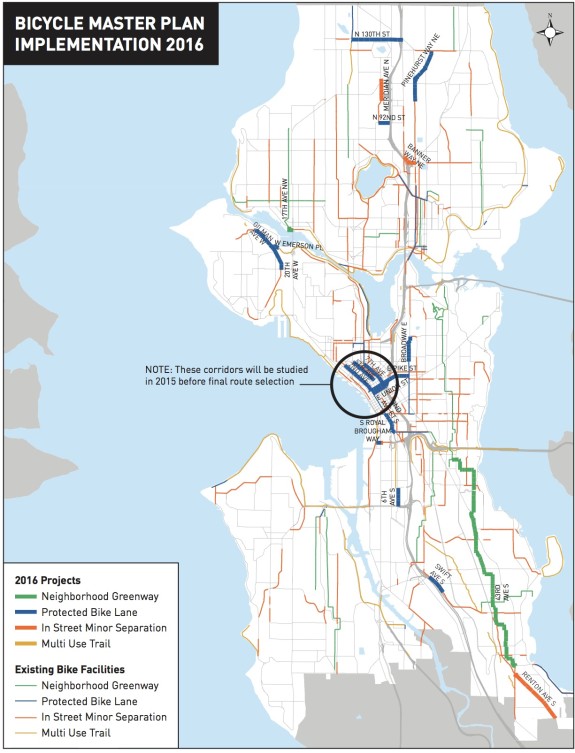 But though this is a five-year plan (PDF), the scope of projects planned slows down significantly after 2015 because so much of the current bike facility funding comes from the Bridging the Gap levy that expires at the end of 2015. If the Move Seattle levy does not win voter approval this fall, the actual budget for bike projects will be obliterated along with major road maintenance and transit efficiency budgets. If the Move Seattle levy is approved, the projected project list will grow.
But though this is a five-year plan (PDF), the scope of projects planned slows down significantly after 2015 because so much of the current bike facility funding comes from the Bridging the Gap levy that expires at the end of 2015. If the Move Seattle levy does not win voter approval this fall, the actual budget for bike projects will be obliterated along with major road maintenance and transit efficiency budgets. If the Move Seattle levy is approved, the projected project list will grow.
So consider the 2017, 2018 and 2019 maps as more of a list of the city’s top priority projects, and be ready to help pass Move Seattle in November so we can do even more:
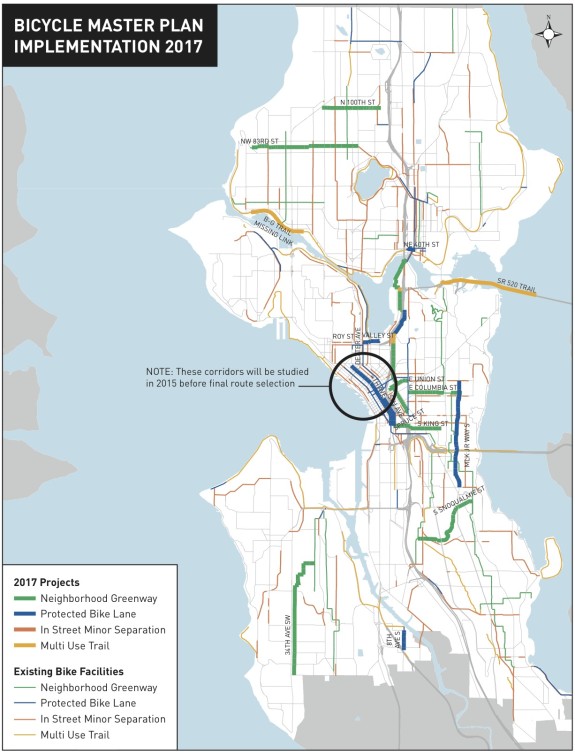
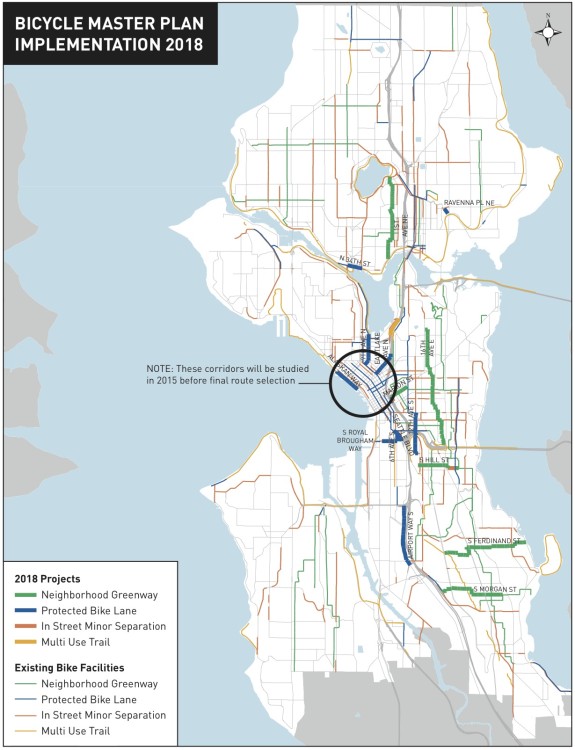
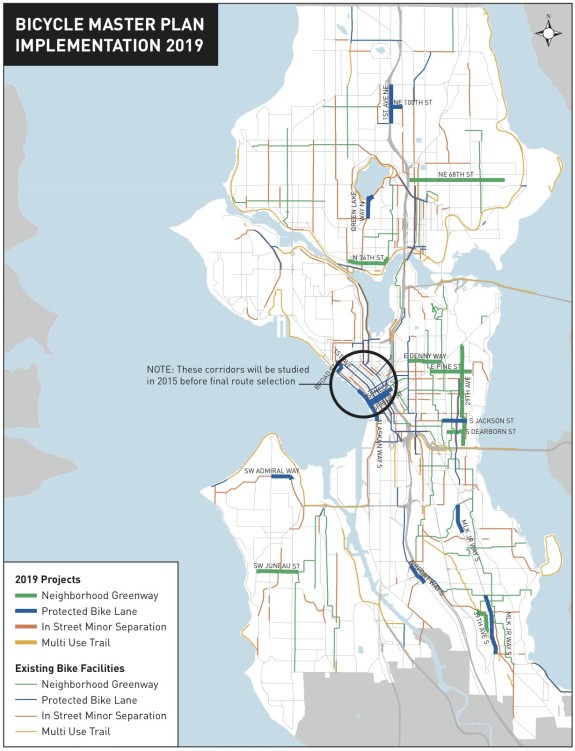 The updated Bike Plan Plan also includes this note about hiring Nicole Freedman to lead the Active Transportation Program:
The updated Bike Plan Plan also includes this note about hiring Nicole Freedman to lead the Active Transportation Program:
The Bicycle Master Plan calls for SDOT to evaluate the need for a bicycle coordinator position (Action 7.2.1). SDOT is addressing this by hiring Nicole Freedman to lead the Active Transportation Program, including launching the new Summer Parkways Program and working on expanding the bikeshare system.
Nicole most recently served as the Director
of Bicycle Programs for the City of Boston.
The program is part of Mayor Walsh’s vision
for healthy, sustainable communities and neighborhoods. During her tenure, she has helped transform Boston from the worst cyclingcity in the country to a recognized leader in cycling. Under her leadership, the city created 92 miles of bike lanes and implemented a successful bikeshare system. Nicole attended MIT before graduating with a degree in Urban Planning
from Stanford University. Prior to working for Boston, Nicole competed professionally in bike racing from 1994-2005, winning two national championships and competing for the United States in the 2000 Olympics in Sydney. Nicole’s first day will be April 22, 2015.No staffing changes beyond hiring the Active Transportation Program Manager are planned.








Comments
27 responses to “City updates short-term bike facilities plan”
I’m just going to put this out there:
https://twitter.com/NEGreenways/status/583892414223388672
I sure hope SDOT can find funding for further improvements to the NE than what is shown in the 5 year plan.
Here here. Far from a comprehensive master plan, it is going to be 5 more years of piecemeal projects that will still leave much of Seattle without anything approaching a connected network. Ignoring the quality of infrastructure, by the end of 2019 NW Seattle will doing okay in terms of a connected network, but NE, SE and SW Seattle will still have numerous gaps.
I’m glad the SDOT do plan on adding protected bike lanes on N 130th in 2016 if not this year. However, it is quite disappointing to see that they have no intention of adding any, much less protected, bike lanes on the section of Roosevelt Way NE that connects NE 125th and N 130th in five years, or of improving the extremely poorly-implemented bike lanes on NE 125th all the way down to Lake City Way. Neither do they plan on installing any bike lanes on 15th Ave NE between NE Northgate Way and NE 125th. As someone who lives and bikes in Pinehurst, bike lanes on Pinehurst Way NE make little sense. That street carries far less traffic than 15th and doesn’t need bike lanes IMO.
NE and Lake City get the shaft…
Don’t they? At the very least, arterial roads going east-west need protected bike lanes between Lake City Way and Aurora, especially in light of the LINK stations opening on 145th, 185th and potentially 130th. The existing bike lanes on 125th are a joke, so are the ones on 185th. I’m not even sure there are bike lanes on 145th at all.
NE 98th street would be prime for calming and a steep greenway. It is a through route between 35th ave he and 15th. With a signaled crossing at LCW
A bit off, but how steep is NE 98th? I often ride to Wedgwood from Pinehurst. I usually take NE 125th and turn south onto 35th, but I face a steep hill going up 35th this way. If I can avoid that by taking 15th -> 98th, I’d like to try the route.
98th is steep. But direct. We need one these around there.
http://trampe.no/en/home
I’m not sure exactly why the bike lanes on Ravenna between the udist and Green Lake need to be turned into protected bike lanes. Seems like those resources could be better used elsewhere. That’s one of the oldest bike lanes around and bikers and drivers all seem to get along fine there. How did this get higher priority than other objects?
Totally agreed. I ride in the Ravenna bike lane between 12th and Green Lake a few times a week. They are already buffered, if not protected with bollards. They are also placed next to the median instead of the parking strip, so there’s no chance of getting doored. I’d like to have the same type of bike lanes all around Green Lake.
Well, that’s likely part of the reason: They’re already good and wide, so relatively easy (and cheap) to make protected. The major intersections where the bike and turn lanes cross paths could be a lot better.
Example from today: https://twitter.com/negreenways/status/584478878342651904
I’ve actually never run into a situation like that. I _have_ had to slow down to let cars cross paths into the left-turn lane, but that’s easily manageable. I’d rather they do something for the intersection between Ravenna and East Green Lake Way N, where they switch the bike lane from the inside to the outside of the general-purpose lane. For those of us who ride westbound on Ravenna and continue onto East Green Lake Drive N, it can be very tricky. I usually move over to the right way before the intersection.
I have to admit, I’m skeptical of fitting a safe separated facility on Dearborn under I-5.
The existing bike lane is truly awful, doesn’t come close to meeting even minimum AASHTO standards, but will the city really accept the cost in right-of-way and separate signal phases necessary to make a separated path safe through the freeway interchange?
“West Seattle, I guess you get nothing. Sorry.” Well, not quite nothing – a valuable greenway route parallel to part of 35th Ave SW (“I-35”) that links public and private schools, library, community center and playfields, and somehow protected bike lanes at the top Admiral Way SW, which could be part of work on the bridges there.
We don’t want to take away from the vital improvements needed in other areas like Rainier Valley, Lake City, Capitol Hill, downtown. So we need more funding and faster development. The Move Seattle levy proposal will help with crucial funding. It will help a lot more if the proposed mix would include a better proportion of funding to help people use bikes and walking for transportation and connection to transit and to free up street capacity for buses and trucks.
But it is really disappointing to see how little is shown to be accomplished by 2019 in West Seattle and some other areas. Not even the BMP-mapped greenways parallel to California Ave SW to the West Seattle (Alaska) Junction, one of the fastest growing urban village centers in Seattle. The work plan is missing BMP-mapped greenways to several WS elementary schools, both middle schools and both high schools, and greenways between the Admiral, Alaska and Morgan Junctions, which would be perfect bike share locations at shopping and all the new apt buildings with minimal car parking. It is missing most WS citywide routes including Fauntleroy to Lincoln Park and the Vashon Ferry, and the Fauntleroy Boulevard project at the rapidly growing triangle area. I don’t know how we will sustain the great interest we have right now in West Seattle when people see these plans and compare them to what they fought to get included in the BMP during 2012-3. Need $$$. Will work for food.
Re: Don’s point.
I think an initial focus on a single part of the city (Cap Hill/Downtown) and building a rich bike network there is brilliant. Basically, the best argument I’ve seen for that is:
http://www.bccc.bc.ca/take-action/470-2/
Portland also focused around building a useful bike boulevard network in one part of the city (SE) with high mode share, and then focused on to building up another part (NE), rather than trying to spread small bits of insufficient infrastructure all over the city in the spirit of equity.
Does seem weird that there’s literally no family-friendly infrastructure in all of West Seattle 5 years though.
Eli, I agree with you in theory.
However, there is so much existing (and heavily-used, good) bike infrastructure sprinkled throughout the city, like the Burke. I wish they would implement a dense network centrally, and ALSO build connections to existing popular bike infrastructure further out from the core. The 12th Ave Greenway is a perfect example of this – #1 priority there should be connecting it to the existing Ravenna Blvd buffered bike lanes and the Burke. Yet, it doesn’t seem important enough for http://www.seattle.gov/transportation/RavennaPBL.htm to make mention of any 12th Ave Greenway connection. Likewise, I see an east-west AAA connection on the south part of the greenway, but the connection to the Burke appears to be “in-street minor separation” (I think; the orange and red colors on their map are difficult for me to tell apart). If that’s the case, that’s a huge failure. You don’t connect two AAA facilities with painted stripes!
I am curious about the plan for the neighborhood greenway on 17th Ave NW between Ballard Ave and 45th. It is shown on the map as a 2015 project but in the table in the PDF it is listed as a 2016 project. Hopefully it will come in 2015 and not 2016.
I was looking specifically for information about what will change to make the crossing of 17th at Leary safe. 17th is an obvious route from Ballard onto the BG trail except for the fact that the 17th and Leary intersection has no marked crosswalks, 3 streets intersecting and cars zooming by. I don’t feel safe crossing here so how would anyone expect kids or new riders to feel ?
The crossing of Leary will be at Dock Pl with a new signal for bike and pedestrians.
Here’s the most recent project factsheet.
http://www.seattle.gov/transportation/docs/green/Ballard%20Greenway%20Fact%20Sheet.pdf
I am sooo looking forward to that signalized crossing at Leary. So very needed.
Thank you for the link. The signal will help a lot. However it doesn’t seem like there is anything that will be done to get safely from Dock place and Shilshole Ave to the 45th street. This is also unsafe. I know there is a crosswalk east of 17th but people will need to get there although very, very few cars ever stop.
It is great to see funds being directed towards realizing the Bicycle Master Plan, but I agree with Mr. Salomon that there are a lot of missing connections in NE Seattle that need attention. It is good to see improvements in the SE parts as well as needed improvements in downtown.
That said, I missed the chance to bring this up earlier but I find it important to bring attention to the following:
With continued funding for the BMP being dependent on the Mayors Move Seattle Levy passing, I need to ask how this request for almost an additional 1 billion dollars (199 million) squares with what we are already being forced to spend for the deep bore tunnel and waterfront “improvements”?
Nobody has taken the Mayor or any of the other tunnel supporters to task about this. Nobody was willing to allocate viaduct replacement monies towards improving surface mobility and circulation, in fact it was politically sidelined as an option. But here we go adding almost another billion to the three already promised, just to get what was being asked for in the first place!
It feels like we are throwing good money after bad here.
[…] Now, the project team has made it very clear that their project ends at Aloha, but that just means SDOT should start work on a new 10th Ave E bike lanes project to connect Broadway to the planned 520 Trail connection at Roanoke Park. It’s listed in the Bike Master Plan, but it’s not currently on the city’s five-year implementation plan. […]
[…] There are also other issues at play but one of the biggest challenges for project is how to deal with the bikeway terminus at E Aloha. The current plans call for only a turn box at the bikeway’s northern start and end point. One solution could be to simply eliminate the terminus. The project team has made it clear that their project ends at Aloha, but that only means SDOT would need to start work on a new 10th Ave E bike lane project to connect Broadway to the planned 520 Trail connection at Roanoke Park. The project is listed in the Bike Master Plan, but it’s not currently on the city’s five-year implementation plan. […]
[…] city’s short-term bike plan includes an extension of the Broadway Bikeway from its current terminus at Denny to Aloha (though a […]
[…] five-year total for protected bike lanes has been cut from 36 miles to 25 miles compared to last year’s version, and the total for neighborhood greenways has been cut from 52 miles to 32 […]
[…] Bike Master Plan Implementation Plan (PDF) — the agency’s most recent annual blueprint for rolling out bike infrastructure projects over the following five years. But to the frustration […]